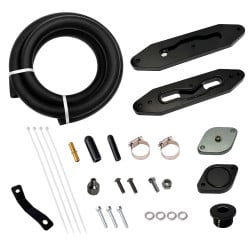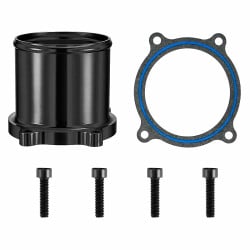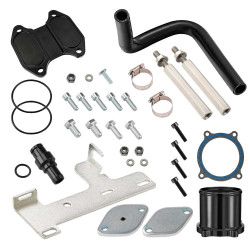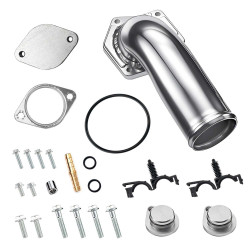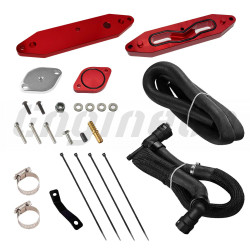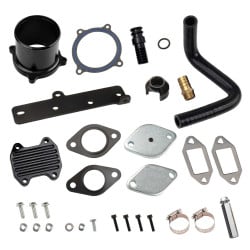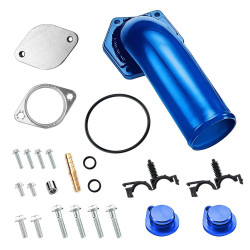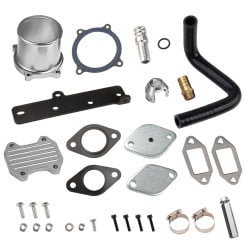Introduction
Modern diesel engines use an Exhaust Gas Recirculation (EGR) system to meet emissions rules. The EGR valve routes some exhaust gas back into the engine intake, which lowers combustion temperatures and cuts harmful nitrogen-oxide (NOx) pollutants. However, recirculating exhaust also sends soot into the intake tract, where it can accumulate. Over time this buildup can reduce efficiency and create maintenance headaches.
An EGR delete kit is an aftermarket modification that physically blocks the factory EGR path. By installing block-off plates and new piping, the delete kit stops exhaust from re-entering the engine. This often leads to noticeable performance gains: many owners see improved throttle response, horsepower, and fuel economy after an EGR delete.
For example, many aftermarket EGR delete kits are designed to fit popular diesel trucks such as Ford Powerstroke, Dodge Cummins, and GM Duramax models. A properly installed delete kit replaces the restrictive factory EGR components with simpler, free-flowing passages, allowing the engine to breathe cleaner air. To better understand how an EGR delete works and why it's popular among diesel owners, let's first take a closer look at the EGR system itself.
What Is an EGR System and How EGR Systems Work?
EGR stands for Exhaust Gas Recirculation, a technology used on nearly all modern diesel engines. In practice, the EGR valve meters a controlled amount of exhaust gas back into the intake manifold. By diluting the intake charge with inert exhaust, the peak combustion temperature is lowered, which dramatically reduces NOx formation. In other words, EGR cuts pollution at the expense of burning a bit of exhaust-soaked air.
A typical diesel EGR system includes:
- EGR Valve: Regulates the amount of exhaust gas re-entering the intake.
- EGR Cooler: Cools the exhaust gas before it mixes with the intake air, improving the effectiveness of NOx reduction.
- Piping and Sensors: Direct and monitor exhaust gas flow through the system.
Different truck manufacturers (Ford, Dodge, GM) implement slightly different EGR designs, but all modern diesel trucks use similar combination of valves, coolers, and sensors to control exhaust gas recirculation.
Common Problems with EGR Systems
Because EGR systems recirculate dirty exhaust back into the engine, they are prone to several problems over time:
- Carbon Buildup Clogging: The EGR system frequently causes carbon buildup in critical components such as the EGR valve, EGR cooler, intake manifold, and throttle body. As exhaust gas is rerouted back into the intake, soot and oily residues settle on these surfaces, eventually restricting airflow and affecting engine performance. Moreover, because EGR reduces combustion efficiency, it increases particulate matter (PM) production, which in turn accelerates Diesel Particulate Filter (DPF) clogging and forces more frequent regeneration cycles.
- If your vehicle’s EGR system hasn’t shown any cloggings yet, or if you are dealing with only mild carbon buildup, preventive maintenance can save you significant repair costs down the road. In these cases, you can perform on-car EGR cleaning using a specialized EGR cleaner spray. This involves applying the cleaning solution through the intake system or EGR channels to dissolve soot and carbon deposits without removing any parts. At most repair shops, professional on-car EGR cleaning typically costs between $100 and $200, depending on the vehicle and location. This preventative service can restore some EGR function and delay more serious buildup.
- However, if the EGR valve or EGR cooler becomes heavily clogged or fails completely, replacement costs can be substantial. For example, for a 2015 Ford F-250 Super Duty 6.7L Powerstroke, replacing just the EGR valve can cost over $260 at parts retailers like AutoZone. Since a complete EGR system also includes the EGR cooler, piping, gaskets, and bolts, the total repair cost—including parts and labor—can easily exceed $1,000. One major reason for the high expense is that servicing the EGR system often requires dismantling a significant portion of the engine, making the job both time-consuming and labor-intensive.
- Rough Idle and Power Loss: A stuck or malfunctioning EGR valve can cause uneven idle, hesitation, or stalling.
- Check Engine Light (CEL): Faulty EGR operation often triggers diagnostic trouble codes and illuminates the check engine light. We will cover EGR-related trouble codes in more detail in a dedicated article on our blog.
- Engine Knocking: Without proper EGR cooling, combustion temperatures rise, leading to engine knocking or pinging under load.
Fixing EGR issues can be expensive and time-consuming, which is why many diesel owners choose to install an EGR delete kit to avoid these problems altogether.
What Is an EGR Delete Kit?
An EGR delete kit is a set of parts designed to disable the factory EGR system. After installation, the engine no longer recirculates exhaust gas into the intake. Instead, all exhaust gases exit through the regular exhaust system.
Components of an EGR Delete Kit:
- Block-off Plates: Seal the EGR valve and cooler ports.
- Replacement Pipes or Bypass Tubes: Provide new routing for exhaust or coolant if the cooler is removed.
- Gaskets and Hardware: Ensure airtight seals and proper installation.
These parts together block the EGR flow, allowing for cleaner intake air, better performance, and less soot buildup inside the engine.
How an EGR Delete Kit Works?
When you install an EGR delete kit, you remove or block the EGR valve and cooler. Instead of recycling exhaust gas into the intake, all exhaust is expelled through the exhaust pipe.
One moe thing should be attention, because most diesel truck computers (ECUs) are programmed to expect EGR operation, deleting the EGR usually requires a tuner/reprogrammer. This tuning disables EGR-related codes and ensures the engine runs smoothly without triggering check engine lights.
Benefits of Installing an EGR Delete Kit
Removing a diesel engine’s EGR (Exhaust Gas Recirculation) system can significantly improve performance and reliability. By eliminating exhaust gas recirculation, the engine breathes cleaner air, leading to stronger combustion, increased horsepower and torque, and reduced carbon buildup in the intake manifold and valves. In short, installing an EGR delete kit brings several key advantages:
- Higher Power and Torque: More fresh air in the combustion chamber leads to stronger burning of fuel. Owners often find sharper throttle response and measurable gains in horsepower/torque after EGR deletion.
- Improved Throttle Response: With no EGR re-circulation, the turbo and engine react faster to throttle changes. The engine responds more immediately, making acceleration quicker and the driving experience feel more responsive.
- Cleaner Intake & Longer Engine Life: Blocking exhaust gas from re-entering the intake means far less carbon buildup on valves and in the intake tract. This cleaner air path helps engines run smoother, and reduced carbon translates to less frequent cleaning or rebuilds – effectively extending engine life
- Potential Fuel Economy Gains: Many users notice better fuel mileage after an EGR delete. By allowing optimal combustion (especially under heavy load or towing), some drivers report around 5–10% improvement in fuel economy.
Results vary by driving style and engine.
- Lower Maintenance Costs: An EGR delete removes common failure points. Problems like clogged EGR coolers or valves are eliminated, reducing service issues and related downtime. In the long run, fewer emissions parts mean fewer things that can break or foul and fewer forced DPF regen events caused by EGR problems.
Each of these benefits contributes to a more capable, trouble-free diesel engine when used in the appropriate context.
Which Trucks Benefit Most from an EGR Delete?
EGR delete kits are most commonly used on heavy-duty diesel pickups and trucks where EGR systems are known trouble spots. In particular, large turbo-diesel engines on Ford, GM, and Dodge pickups see the biggest gains. Popular applications include:
- Ford Super Duty (F-250/F-350/F-450): The 6.0L and 6.4L Powerstroke models (2003–2007) and the 6.7L Powerstroke (2011–present) are often EGR-deleted. These engines benefit from improved breathing under heavy towing or hauling.
- Dodge Ram 2500/3500: Vehicles with Cummins diesel engines, especially the 5.9L/6.7L Cummins used in Ram 2500–3500 trucks, are common candidates. Owners of Cummins engines often seek deletes to eliminate EGR cooler failures and soot build-up.
- Chevrolet/GMC 2500/3500 (Duramax): Early Duramax engines (LB7, LLY, LBZ models) and later models can gain from EGR deletion. Diesel enthusiasts cite better performance in towing when the Duramax EGR system is blocked off.
While less common, some off-road and race diesel vehicles (equipment, tractors, etc.) also use EGR deletes to maximize power. Light-duty trucks and gasoline engines are rarely modified this way in the U.S. In general, any turbo-diesel truck that frequently sees high load or has known EGR problems will benefit the most.
However, the modification must be done carefully and legally (see below).
Important Considerations Before Deleting Your EGR
Vehicle Diagnostic Codes and ECU Tuning
Deleting the EGR system is a mechanical change that the engine's computer will notice. The vehicle's onboard diagnostic system will see that the EGR flow is absent and usually set trouble codes (Diagnostic trouble codes beginning with P040 are among the most common indicators of EGR flow problems). In practice, this means an unchecked EGR delete will typically trigger the Check Engine Light. To avoid persistent error codes and limp-home mode, a software tune or aftermarket module is almost always required. An ECU tuner will reprogram the engine calibration to disable the EGR-related sensors and compensate for the change. In other words, to delete the EGR correctly, you generally need to tune or flash the ECU so the computer expects the deletion and runs the engine properly. Many EGR delete kits are sold together with or recommend a matching performance tune.
Without proper tuning, symptoms can include repeated EGR fault codes, unresolved warning lights, or even engine derates. Professional installers and reputable kits will address the ECU side – either by providing a tune file or instructions – to ensure the truck runs smoothly. It’s important to plan for this: factor in the cost of an authorized tuner or an EGR-canceling module when considering an EGR delete.
Legal and Regulatory Compliance
It’s important to understand that deleting or disabling the EGR system is illegal for vehicles operated on public roads in the United States. According to federal law under 40 CFR Part 86, removing emissions control devices, including the EGR system, violates the Clean Air Act.
EGR delete kits are intended for off-road or competition use only, such as race vehicles not registered for street use. Driving an EGR-deleted truck on public highways can result in fines, emissions test failures, and other legal penalties.
Always consult local regulations and seek advice from a qualified legal expert if you are considering emissions modifications.
